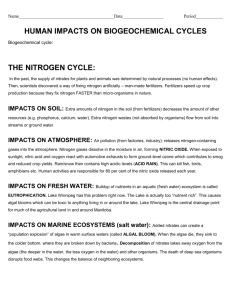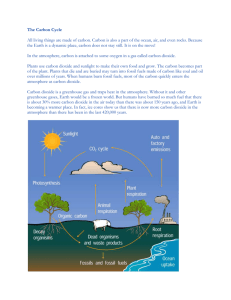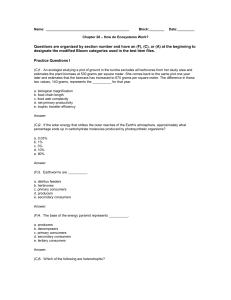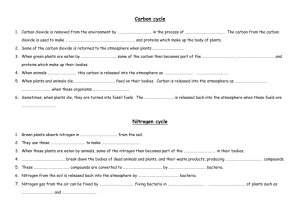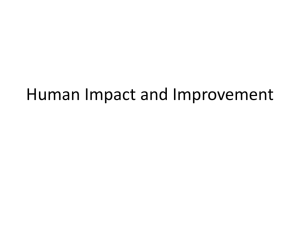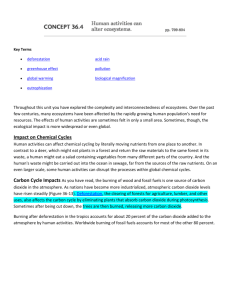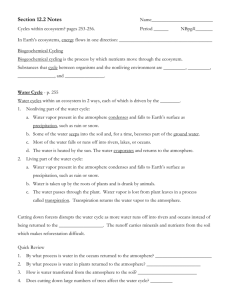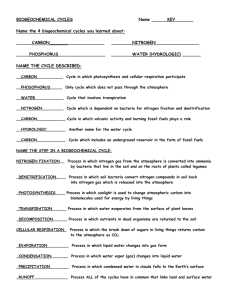Ecosystems Topic 4: Trophic Levels
advertisement
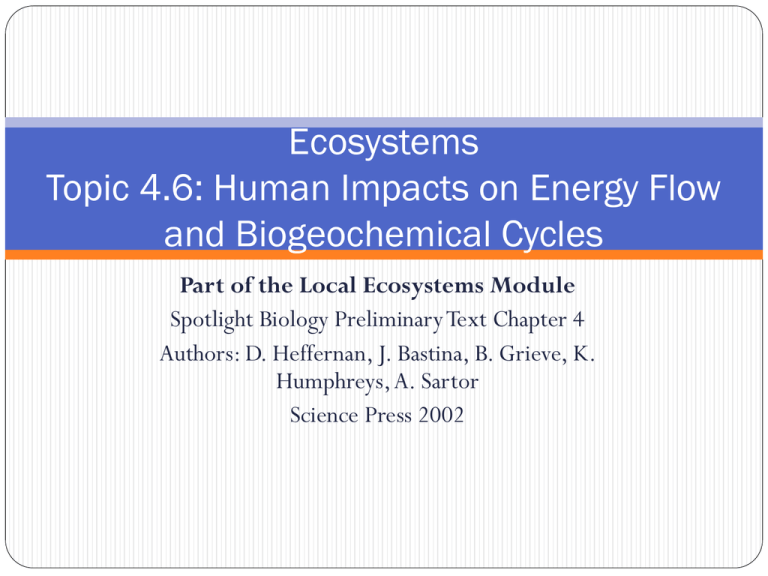
Ecosystems Topic 4.6: Human Impacts on Energy Flow and Biogeochemical Cycles Part of the Local Ecosystems Module Spotlight Biology Preliminary Text Chapter 4 Authors: D. Heffernan, J. Bastina, B. Grieve, K. Humphreys, A. Sartor Science Press 2002 Human impacts on Energy Flow and Biogeochemical Cycles The natural processes and systems on Earth are balanced and designed to sustain life. With the growing human population and the advance of technology, we are having an impact on these balanced systems. examplesof.com Human impacts on The Water Cycle We have recently discovered that water often cycles more locally and rainfall patterns are often strongly influenced by living organisms. It used to be believed that the water cycle was this giant physical phenomenon that affects life but is itself little affected by life. kidzone.ws Human impacts on The Water Cycle For example, trees in a tropical rainforest return a great deal of water to the atmosphere through transpiration from their leaves. Much of this moisture feeds the heavy local rainstorms that keep the forest well watered. en.wikipedia.org So removing large areas of rainforest interrupts this cycle and can cause major, long lasting changes to local climate. Human impacts on The Water Cycle We use a huge amount of fresh water for a range of daily activities which includes general use at home, irrigation of gardens and crops, mining, steel production and other industrial processes. These are all non-natural uses of water. ga.water.usgs.gov Human impacts on The Water Cycle Much of Central Australia’s current water supply is pumped from the underground Great Artesian Basin. This water is being used faster than it’s being replaced. How will this affect future generations? onlineopinion.com.au Human impacts on The Water Cycle In some parts of the world, water shortages have the potential to provoke wars between nations. As we continue to alter the face of the biosphere we MUST understand how our changes to the environment may affect the water cycle. pdnonline.com Human impacts on The Carbon Cycle Over the last two centuries, humans began to alter the carbon cycle in two ways: 1. Cut down some of the world’s great forests, particularly the tropical rainforests and many trees destroyed were then burnt. 2. Burning large quantities of stored carbon: fossil fuels like coal, oil and gas. mypowerplants.blogspot.com Human impacts on The Carbon Cycle Cutting down trees destroys living tissue that fixes atmospheric carbon dioxide, and then burning them immediately returns the carbon dioxide they contain to the atmosphere dailyinterestingfacts.com Human impacts on The Carbon Cycle Removing stores of carbon in the form of coal, oil and gas and burning them also returns carbon dioxide back into the atmosphere. This unbalances the cycle because more carbon dioxide is being out into the atmosphere than is being removed. en.wikipedia.org Human impacts on The Carbon Cycle These two forms of combustion has returned enough carbon dioxide to the atmosphere to raise its atmospheric concentrations measurably. organicconnectmag.com Human impacts on The Carbon Cycle We need carbon dioxide in the atmosphere. This gas traps heat and keeps the Earth’s temperature stable. We call this natural balance the greenhouse effect. ucar.edu Human impacts on The Carbon Cycle When humans increased the levels of carbon dioxide in the atmosphere, more radiation is trapped which is leading to a steady rise in global temperature. This is called the enhanced greenhouse effect. usgreentechnology.com Human impacts on The Carbon Cycle World temperatures are going up but no one knows if this is because of the enhanced greenhouse effect or natural climatic cycles. A steady rise in temperature has the potential to affect the biosphere in a number of ways. Changes to climates (drought/flooding) Increased storms Sea level rise Melting of the polar ice caps mypowerplants.blogspot.com Human impacts on The Nitrogen Cycle The nitrogen cycle is being adversely affected by us as well. The amount of nitrogen fixed by natural means, such as bacteria and lightning, is now about the same as that produced by humans. Therefore we are upsetting the natural balance. mypowerplants.blogspot.com Human impacts on The Nitrogen Cycle There are two main ways we add nitrogen to our environment: 1. Cars (when cars burn fossil fuels, the high temperatures inside modern engines produce large amounts of nitrogen oxides. When it rains, these nitrogen oxides dissolve to form nitrates which end up in our soils, lakes and oceans) 2. Fertilisers (farmers use enormous amounts of nitrogen fertilisers in their farms. This eventually makes it into our water systems as well) mypowerplants.blogspot.com Human impacts on The Nitrogen Cycle As a result of excess fertilisers in our water ways is called eutrophication, this causes rapid growth of microscopic algae called algae blooms. How do you think this would this affect an ecosystem? meetyourfood.com Human impacts on The Nitrogen Cycle When the algae die, the bacteria that break them down (decomposition) use most of the oxygen in the water in this process. This produces smelly discoloured water. Not to mention this water is also toxic to humans and animals. ozcoasts.gov.au Energy Flow and Distribution We also interfere with the flow of energy through the ecosystem. More and more of the energy naturally trapped by photosynthesis is being removed for human use and less is left for the natural community. (What does this mean?) carthageagriculture.pbworks.com Energy Flow and Distribution Clearing land for agriculture is a way of redirecting energy from the sun for human use rather than for the natural community. With less energy in its biomass, fewer organisms can be maintained in the natural environment cosmosmagazine.com Energy Flow and Distribution Burning fossil fuels and wood releases carbon dioxide into the atmosphere. This increase in carbon dioxide traps more heat in the atmosphere and interferes with the energy flow. (Why/How?) goinggreen-forlife.com Homework What causes the greenhouse effect and how does this differ from the enhanced greenhouse effect? 2. Describe the two main ways humans take nitrogen from the atmosphere and add it to the soil. 3. Complete Activity 4.6.1 Cycle Diagrams Handout 1.
